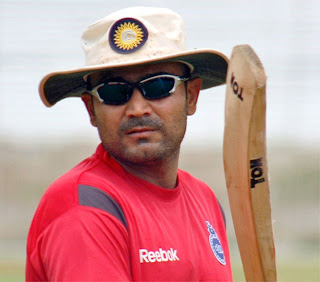Former India captain Sunil Gavaskar on Monday slammed Virender Sehwag’s fielding efforts in the fourth and final Test at Nagpur against England.
"What's unfair? The man was just not bending. What do you expect in Test cricket, against spinners that the catches will come above the knee? The catches will invariably be around the knee or below the knee. By him (Sehwag), standing in a way that he was, he didn't do any favour to the team,” Gavaskar told when asked about the catch of Kevin Pietersen, which Sehwag dropped at the first slip.
"The bowlers, in any case, are finding it hard to get past the outside edge, and when that edge comes you find somebody whose balance is all wrong," he added.
"When you are committed to the team, you do everything. These are five days that's all India is asking for...to give all that you have from the time you step onto the field," the legendary cricketer was quoted as saying by NDTV.
Gavaskar was critical of the Indian support staff, saying they had very little control on the players.
"Today players were waiting for two-three players to complete their interviews by the time they started their warm-ups. This indicates to me that the support staff has zero control on the players,” he said.
Gavaskar added, “They are not able to tell the team that 'let those two players finish their interviews, let's start warming up'. The sooner we start looking into all these matters, better it will be for the Indian cricket."
The former Indian cricketer however heaped praise on Virat Kohli, who had a verbal duel with England batsman Jonathan Trott on the fourth day at VCA Stadium.
Trott tried to cut a delivery off Ishant Sharma, which was taken behind the stumps by MS Dhoni. Umpire Kumar Dharmasena rejected the Indian appeal, after which Kohli ran to Trott and exchanged a few words.
Gavaskar said, "Jonathan Trott has not been very quiet in slip position. He has plenty to say to the Indian batsmen. So Kohli was just giving it back and I think it is a good attitude. I am not for a moment advocating bad words or abuse of the opponent. It's a complete 'no-no' for me.”“But when you are given a bit of a stick by the close-in fielders, it's about time you gave it back when it's your turn to field. So I am very happy with the way Virat Kohli did that and with the way he was joined by Ravindra Jadeja and the others," Gavaskar added.
"That's what the Indian cricket team needs. That's the kind of guys the Indian cricket needs, guys who are 'in-your-face'...guys who are not going to take a step back. That's the kind of cricketers you need," he said.
Gavaskar told the Indian side not to get complacent and underestimate the opponent.
"Don't be complacent, don't be happy with just one performance and never underestimate your opponent. India underestimated their opponent and they have paid the price,” he concluded.
"What's unfair? The man was just not bending. What do you expect in Test cricket, against spinners that the catches will come above the knee? The catches will invariably be around the knee or below the knee. By him (Sehwag), standing in a way that he was, he didn't do any favour to the team,” Gavaskar told when asked about the catch of Kevin Pietersen, which Sehwag dropped at the first slip.
"The bowlers, in any case, are finding it hard to get past the outside edge, and when that edge comes you find somebody whose balance is all wrong," he added.
"When you are committed to the team, you do everything. These are five days that's all India is asking for...to give all that you have from the time you step onto the field," the legendary cricketer was quoted as saying by NDTV.
Gavaskar was critical of the Indian support staff, saying they had very little control on the players.
"Today players were waiting for two-three players to complete their interviews by the time they started their warm-ups. This indicates to me that the support staff has zero control on the players,” he said.
Gavaskar added, “They are not able to tell the team that 'let those two players finish their interviews, let's start warming up'. The sooner we start looking into all these matters, better it will be for the Indian cricket."
The former Indian cricketer however heaped praise on Virat Kohli, who had a verbal duel with England batsman Jonathan Trott on the fourth day at VCA Stadium.
Trott tried to cut a delivery off Ishant Sharma, which was taken behind the stumps by MS Dhoni. Umpire Kumar Dharmasena rejected the Indian appeal, after which Kohli ran to Trott and exchanged a few words.
Gavaskar said, "Jonathan Trott has not been very quiet in slip position. He has plenty to say to the Indian batsmen. So Kohli was just giving it back and I think it is a good attitude. I am not for a moment advocating bad words or abuse of the opponent. It's a complete 'no-no' for me.”“But when you are given a bit of a stick by the close-in fielders, it's about time you gave it back when it's your turn to field. So I am very happy with the way Virat Kohli did that and with the way he was joined by Ravindra Jadeja and the others," Gavaskar added.
"That's what the Indian cricket team needs. That's the kind of guys the Indian cricket needs, guys who are 'in-your-face'...guys who are not going to take a step back. That's the kind of cricketers you need," he said.
Gavaskar told the Indian side not to get complacent and underestimate the opponent.
"Don't be complacent, don't be happy with just one performance and never underestimate your opponent. India underestimated their opponent and they have paid the price,” he concluded.





